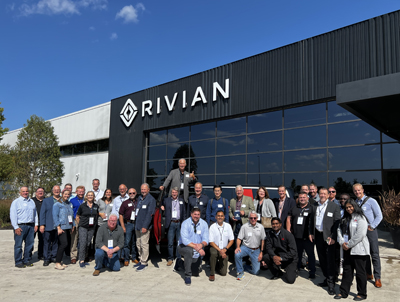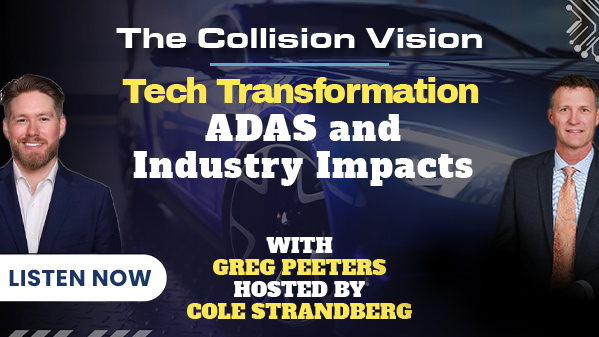Take a look inside the 4 million-square-foot facility in Normal, IL, where Rivian is building the EVs its CEO hopes will change the world.
Whether they are out on an adventure or part of an electrified fleet, Rivian vehicles are all designed with a common goal---to help preserve the world for future generations.
Frank Phillips, Rivian's former senior manager of the Certified Collision Network North America, shared information about the manufacturer’s adventure vehicles at the September CIECA CONNEX Conference in Bloomington, IL. Attendees also had the opportunity to tour the Rivian plant nearby in Normal, IL.
During his presentation, “The Rivian Evolution Revolution,” Phillips discussed what the OEM is doing differently to impact the collision industry, both as an electric vehicle (EV) manufacturer and a certified collision program.
Rivian was founded in 2009 by Robert “RJ” Scaringe, the company’s CEO. Scaringe named the company Rivian after the Indian River in Florida, where he grew up. Phillips said Scaringe, a graduate of MIT, was known by many as an ambitious young man who always wanted to own a car company and revolutionize the world with the vehicles he sold.
Phillips recalls walking into the Rivian factory for the first time and seeing Scaringe on the catwalk. After introducing himself to Phillips and the other 10 people he was with, Scaringe recalled who they were based on information from their resumes.
“At that time, we were about 4,000 employees and he was able to recall who we were,” said Phillips. “That’s the brain power he has.”
Since then, Rivian has grown to include 14,000 employees, which include more than 8,000 who work at the assembly plant in Normal.
“When you think of when the company started and where it is today, it really is an evolution,” he said. “I think Rivian has taken on a revolution at the speed in which we've done some of the things we have.”
Prior to Rivian’s ownership, the plant was operated by Mitsubishi Motors North America (MMNA). Phillips said it was an industry-leading facility in the U.S. with more than 400 advanced robots. The plant closed in late 2015.
“They were going to repurpose the property and it was an opportunity for us to refurbish the facility,” said Phillips. “That's part of our culture and what we stand for. Our intent is to make sure that we keep the world adventurous forever and we become sustainable for our kids to enjoy that adventure as well.”
Since purchasing the property for $16 million in 2017, Rivian has invested about $4.5 billion into refurbishing the plant.
“It's probably one of the brightest, cleanest looking facilities you will walk into,” said Phillips. “A tremendous amount of white paint has gone into getting where we are today.”
The approximately 4 million-square-foot plant builds all Rivian models. Three vehicles, constructed of steel and aluminum, were launched in 2021: the R1T electric pickup truck, the R1S, a seven-passenger SUV, and the Amazon electric delivery vehicle (EDV). Earlier this year, a smaller version of the EDV was launched. The company is producing a fifth product, a service van, an iteration of the EDV designed to travel to Rivian owners’ locations to take care of their service needs.
Phillips said the plant is home to some of the largest robots in the manufacturing business to accommodate EV construction. The massive robots build pieces for Rivian’s EDV, which is 9.5 feet tall.
The refinishing section was designed to be a cutting-edge facility. “There isn't another one like it in automobile manufacturing,” said Phillips.
With a focus on sustainability, Phillips explained each vehicle is painted off an individual packet so there isn't a wash out of lines, compared to a traditional manufacturing facility that pumps in paint. As a result, colors can be changed quickly as vehicles come through the paint shop.
EV Charging Infrastructure
Rivian’s assembly line is similar. There are two lines, one for passenger vehicles and another for the EDV, so Rivian can interchange the R1S and the R1T.
In addition, Rivian has created a recycling program to recondition its batteries.
“Recycling is a great opportunity,” he said. “When an EV battery reaches its end of life, there's still a tremendous amount of life and capability in that battery. It doesn’t just need to be thrown away.”
As the industry moves away from internal combustion engine (ICE) vehicles to battery electric vehicles (BEVs), Phillips foresees charging networks will help drive adoption rates across all EV product lines.
“I absolutely love Rivians,” said Phillips, who owns an R1T and an R1S. “They're fantastic vehicles, but I will confirm… I have charged at Electrify America chargers and others and have been very frustrated.”
Phillips said the recent adoption of the North American Charging Standard (NACS) chargers designed by Tesla will help address infrastructure challenges and lead to more rapidly available and reliable charging.
“Manufacturers are working on solutions to deliver robust, high-powered charging locations nationally and each OEM has a branded strategy to address the gaps,” he added.
Phillips talked about Rivian’s role in contributing to the charging infrastructure. As a new vehicle company, Phillips said the charging network is something leadership understood needed to be addressed to succeed.
“The scope of our company ethos is to keep the world adventurous,” he noted. “When you take your Rivian out on the trail, we want to have a charging network there for you to access.”
In addition to a wall charger and portable charger, Rivian is building the Rivian Adventure Network, a comprehensive network of fast-charging sites, initially capable of adding up to 140 miles of range in 20 minutes to the R1T and R1S. Open to Rivian owners, the network is planned to grow to more than 3,500 fast chargers at over 600 sites across the U.S. and Canada.
Rivian is also collaborating with Tesla to charge its vehicles at more than 12,000 Tesla Superchargers across the U.S. and Canada with an NACS adapter.
Although Phillips said the transition to EVs is an adventure, he encourages repairers and customers to stay positive while the charging infrastructure is implemented.
Rivian Certified Collision Network
When Phillips joined Rivian three years ago, he was tasked with creating a certified collision network across North America with Kelly Logan, Rivian’s director of collision. The first body shop was certified in August 2021; there are now 220 certified locations. They are comprised of four programs under the Rivian Certified Collision Network umbrella: Rivian Certified Collision Centers (RCCC) locations working on R1 products, Rivian Certified Fleet Center (RCFC) locations working on the commercial vans, RCDC locations offering calibration and diagnostics, and RCV locations, B2B partners working with Rivian on predelivery repair needs.
The Rivian collision team is in the field recruiting shops and working with repairers to help them perform better. Each program is designed to address specific customer needs, which Phillips said allows the network to focus on vehicle specialization.
“Flexible program offerings ensure a better customer experience by placing clients in the right locations to start,” he said. “Offering choice also adds appeal to the program by addressing program entry costs.”
Phillips said one of Rivian’s unique features is the manufacturer’s certified diagnostic and calibration program, created to ensure a successful calibration and safe and proper repairs.
“When you look at a Rivian, there are cameras and sensors everywhere so it is going to need calibration if it’s in an accident,” he said.
Since Rivian opened its doors, Phillips said the company is happy with its progress.
“The quality of the Rivian continues to ramp up and improve and they are a treasure to drive,” he said. “Our customers are saying the same.”










Stacey Phillips Ronak